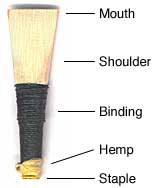|
Bagpipes are a class of musical instrument, aerophones,
using enclosed reeds fed from a constant reservoir of air in
the form of a bag.
The Great
Highland Bagpipes (GHB) consists of a bag, three drones, a
blowpipe, and a chanter.
In essence, a
piper blows through the blowpipe into the bag. The blowpipe
is fitted with a one-way valve that prevents the air from
coming back out the blowpipe when the piper takes a breath.
From the bag, the air passes out through the drones and the
chanter, each making a sound.
The three drones
are composed of two (shorter) tenor drones which are one
octave (eight notes) lower than the
fundamental pitch of the chanter (called "Low A") and
one (long) bass drone, one additional octave lower than the
tenors. The drones each have a single reed which sounds a
pitch (like humming a single note) hence the term "drones.”
Drone reeds can
be made of natural cane, synthetic materials, or a
combination of both.

Moving the bridle on the drone reeds allow the piper to
adjust the pitch. Additional tuning of the drones is
accomplished by
sliding the drones up and down on their tuning slide/pin
(down for sharper, up for flatter). The air pressure moving
across the blade of the drone causes the reed to vibrate and
produce sound.
The chanter has a double reed;
two matched
pieces of (almost universally) Spanish Cane wrapped around a
metal tube called a "staple".
 
The reeds come
in various strengths requiring different amounts of pressure
for the blades to vibrate and produce sound. The pitch of
the chanter is changed by pushing the reed further in or out
of the top of the chanter – in for sharper, out for flatter.
The note sounded
by the chanter is determined by which of its holes are
covered (or not) by the piper's fingers.

Individual notes
of the chanter are tuned by taping the top of the finger
hole to flatten the pitch. A chanter reed requires precise
positioning into the chanter and the chanter holes usually
require precise positioning of tape to sound musical. To
complicate the tuning process, the pitch of the chanter reed
will shift as the instrument warms up, requiring the piper
to retune frequently until the instrument has been
stabilized. Moisture (or lack thereof) also affects the
tuning.
When a piper
takes a breath, the piper's arm applies more pressure to the
bag to maintain a steady pressure and even tone. A bagpipe
played by an inexperienced or "unsteady blower" will waver
in pitch and sound out of tune.
Bagpipes require
a lot of stamina to play for any length of time. Pipers
spend their careers learning to maintain steady pressure and
mastering tuning, but the results are a truly wonderful
experience. |

